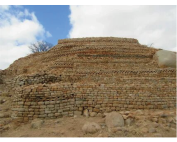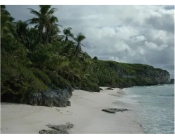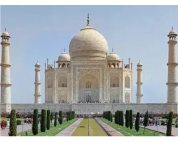1 . If you’d like to go sightseeing, the following World Heritage Sites may be your best choices.
Jiuzhaigou Valley Scenic and Historic Interest Area

Jiuzhaigou Valley, which lies in the northern part of Sichuan Province, China, reaches a height of more than 4,800 m, with a series of different forest ecosystems (生态系统). It’s particularly famous for its excellent waterfalls. About 140 kinds of birds live in the valley, as well as a number of endangered plants and animals, including the giant panda. Jiuzhaigou Valley was recognised as a World Heritage Site by UNESCO in 1992.

Khami Ruins National Monument
The city of Khami, which developed after the capital of Great Zimbabwe had been given up in the mid-16th century, is of great archaeological (考古的) interest. The discovery of objects from Europe and China shows that Khami was a major centre for trade over a long period of time. It joined the World Heritage List in 1986.

Henderson Island
Henderson Island, which lies in the eastern South Pacific, is one of the few atolls (环礁) in the world whose ecology has been untouched by humans. It’s particularly famous for the 10 plants and 4 birds that can only be seen on the island. It was recorded in the World Heritage List in 1988.
The Taj Mahal

The Taj Mahal is considered to be one of the most beautiful buildings in the world and the finest example of the late style of Indian architecture. It was built by the emperor Shah Jehan, who ruled India in the 17th century. It was in memory of his favourite wife who died in 1631. The architecture was given a World Heritage Status in 1983.
1. Which of the following can be found in Jiuzhaigou Valley?| A.Wonderful waterfalls. | B.Ancient objects. |
| C.Beautiful buildings. | D.Untouched ecology. |
| A.It doesn’t exist now. |
| B.It was built by an emperor’s wife. |
| C.It has become a place of interest. |
| D.It looks more beautiful than other buildings. |
| A.Industry. | B.Travel. |
| C.Science. | D.Business. |
2 . Tips for avoiding traffic jams:
The radio has more than just music. Check the local news station for the latest traffic report. Or go online and check traffic cameras before you set out. If there is a jam, you'll be prepared and can try another route.
Take the road less traveled. Although highways may be the most direct route, back roads can be much less crowded, which can save you from the frustration of the stopandgo traffic.
Rush hour isn't just a lovely nickname. It means the morning and afternoon traffic lasts for several hours, but they're still called “rush hour” for a reason — everyone's on the road and in a hurry to get somewhere. Treat rush hour like bad weather — if you don't have to go anywhere, stay off the roads.
Tips for those unavoidable traffic jams:
Don't break the law. You've gone 30 feet in 30 minutes and all of a sudden you see people using the shoulders (紧急停车道). Don't behave like them. Not only is this illegal, but also there's a good chance they'll get caught or cause even more problems.
Pay extra attention to zigzaggers (Z字形行进者). When some people are anxious, they may start changing lanes (车道) every 5 seconds or cut you off. Keep checking your windows and mirrors for these lane changers.
Look for an escape. If it is possible to exit the road safely, do it. Use a GPS unit, and you can change your route midtrip if needed.
Be courteous. Good manners could help you avoid a possible accident. Allow people in from a lane that is ending. Speeding up to keep them out increases your chances of an accident.
1. To avoid traffic jams, we are advised to do the following EXCEPT ________.| A.getting traffic news before leaving | B.choosing back roads |
| C.avoiding rush hours | D.changing lanes frequently |
| A.Keep checking the mirrors. | B.Stop and let them go first. |
| C.Sound the horn loudly. | D.Drive quickly to keep them out. |
| A.Energetic. | B.Polite. | C.Careful. | D.Honest. |
| A.Entertainment. | B.Life. | C.Market. | D.Advertisement. |
3 . Most of what I really need to know about is how to live, and what to do, and how to be, I learned in kindergarten. Wisdom was not at the top of the graduate school mountain, but there in the sandbox at nursery school.
These are the things I learned: Share everything. Play fair. Don’t hit people. Put things back where you found them. Clean up your own mess. Don’t take things that aren’t yours. Say you’re sorry when you hurt somebody. Wash your hands before you eat. Flush. Warm cookies and cold milk are good for you. Live a balanced life. Learn some and think some and draw and paint and sing and dance and play and work some every day.
Take a nap every afternoon. When you go out into the world, watch for traffic, hold hands, and stick together. Be aware of wonder. Remember the little seed in the plastic cup. The roots go down and the plant goes up and nobody really knows how or why, but we are all like that Goldfish and white mice and even the little seed in the plastic cup – they all die. So do we.
And then remember the book about Dick and Jane and the first word you learned, the biggest word of all: LOOK. Everything you need to know is in there somewhere. The Golden Rule and love and basic sanitation, ecology and politics and sane living.
Think of what a better world it would be if we all – the whole world – had cookies and milk about 3 o'clock every afternoon and then lay down with our blankets for a nap. Or if we had a basic policy in our nation and other nations to always put things back where we found them and clean up our own messes. And it is still true, no matter how old you are, when you go out into the world, it is best to hold hands and stick together.
1. In this passage, the author intends to ___ .| A.inform the readers of what he learned in kindergarten |
| B.call on people to hold hands and stick together |
| C.show the importance of enlightening (启蒙) education |
| D.tell people how to live a successful life |
| A.Cook cookies and dishes. |
| B.Keep the things he used in place. |
| C.Look out for traffic. |
| D.Make an apology to someone he hurt. |
| A.must be a success thanks to the good habits. |
| B.has learned to share everything with others |
| C.expects harmony and unity |
| D.is at an old age now |
| A.Popular Science. | B.Entertainment. | C.Fashion. | D.Life Guide. |
4 . Some of the best thing in life don’t happen until you grow old enough to recognize them. I can say that about tea. .
I didn’t start to drink tea until I was 35. The first time felt a genuine urge to drink tea was in 2003, when I stayed briefly in the United Kingdom. After a time of consuming local food, I started to really like strong black tea.
I took packs of green tea with me as gifts but was disappointed to find my British friends preferred much stronger black tea from Sri Lanka. Later I learned that although people know China for its tea, it ranks only third among the world’s black tea exporters, after Sri Lanka and Kenya.
After I came back to China and started to cover food stories, I met friends in the tea-drinking circle and learned more. Although the majority of the rest of the world drinks black tea, which the Chinese call “red tea”, China processes and drinks mostly green tea.
I feel lucky to be Chinese because of the great variety of tea available in the county. It is estimated that there are more than 2000 tea in China it you divide them geographically,] including more than 600 locally famous tea. A more simple way to categorize it is by color ; and extent of fermentation(发酵). That comes down to six main categories --- green, white, yellow, dark greenish(oolong), red and black tea.
Tasting tea can be compared to our life. It can be plain and predictable but sometimes it is j full of pleasant surprises. Occasionally it can even seem too good to be true. The best thing is, you know there’s always more to explore.
1. Which country ranks first among the worlds black tea exporters?| A.China. | B.Sri Lanka. |
| C.Kenya. | D.United Kingdom. |
| A.journalist | B.manager |
| C.scientist | D.tea grower |
| A.varieties of tea is planted and produced each year in China |
| B.tea in China can be divided into more than 2000 categories geographically |
| C.tea in China can be categorized by color and extent of fermentation |
| D.all tea in China can be divided into six categories with no exception |
| A.World. | B.Business. |
| C.Lifestyle. | D.Travel. |



